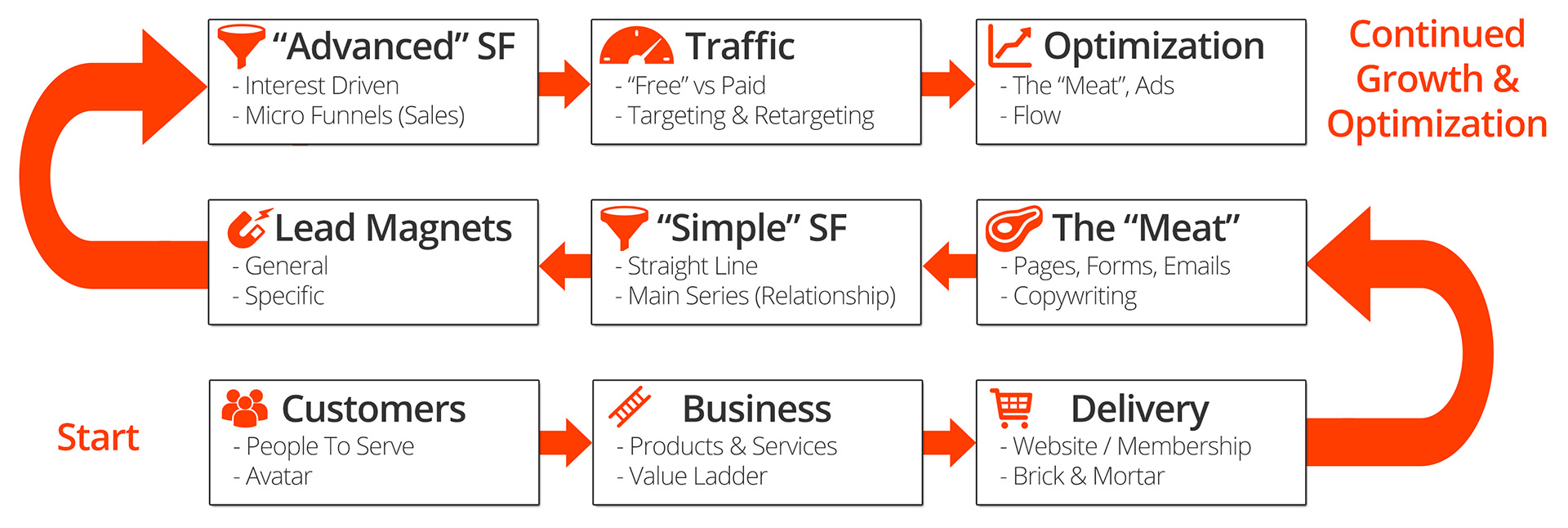All too often the phrase “sales funnel” is used interchangeably with “email marketing.”
I know I've done it … and it's wrong.
Email marketing is part of a sales funnel – it's not the sales funnel.
While email marketing tends to be the glue that holds the funnel together, there are many other pieces involved.
There's the audience you need to attract through advertising.
There are the products and services you offer.
There are landing pages, optin forms, lead magnets, relationship building materials (blog posts, videos, etc.), sales pages, and thank you pages.
Then there's all of the tracking, optimization, metrics, and split tests.
And yes, of course, all the emails, series, and sequences that “connect” everything together.
It's a lot.
It takes a combination of technical skills and marketing abilities to craft a top performing sales funnel.
I don't say all of this to overwhelm you.
I say all of this so you're aware of what you need to learn and master.
This post is to serve as a framework or guide through the pieces that make up a sales funnel.
The Sales Funnel Framework
I've spent the better part of 2 years focusing solely on sales funnel development and after lots of trial and error, I've realized that all successful sales funnels need to incorporate these 9 specific areas:

Any great sales funnel/system has to start with its Customers. Who are they? Where do they hangout? What do they look like? What are their goals, dreams, desires, fears, pains, and problems?
Your Business consists of the products and services you deliver to your customers that help them achieve their goals, dreams, and desires while avoiding fears, pains, and problems. The products and services should be positioned to offer an array of different price points, up-sells, down-sells, and cross-sells (a value ladder).
Your Delivery System is how you get your products and services into the hands of your customers. This can be accomplished through a website, ecommerce store, membership portal, or even via brick & mortar.
The “Meat” is the best phrase I could come up with to describe all the content within a sales funnel. All of the sales pages, squeeze pages, opt-in forms, emails, etc. are included here … and of course, require some copywriting skills.
A “Simple” Sales Funnel is the starting point. While it’s the simplest of all sales funnels, it can yield some incredible results and it’s the place you need to start before moving onto bigger, “better”, more advanced sales funnels.
There are two types of Lead Magnets: general and specific. Both are used to attract leads; however, one gauges interest and intent while the other is more for “everyone.” Knowing when and how to use each type is one of the keys to success.
An “Advanced” Sales Funnel can take a lead, figure out their specific interests, and distribute tailored content to those individuals … improving relationships and increasing sales with little effort.
You need Traffic in order to keep your sales funnel full. While there are many ways to drive traffic, the best way is to hangout where your ideal customers hangout.
Finally, in order to have continued growth, you’ll need to test, tweak and Optimize your entire system in order to achieve the best results possible.
Preface
Customers
Business
Delivery
The “Meat”
- How To Steal Other People's Copy
- 2 Sales Page Formulas From Michel Fortin
- What Is A Landing Page?
- Landing Page Myths & Experiments
- What Should I Send To My Email List?
- How To Write Action Driving Emails That Increase Conversions
- How To Insert Expiring Links Into Your Autoresponder
- 3 Email List Growing Tools That Are Free!
- The Tools We Use To Build Our Sales Funnels
“Simple” Sales Funnel
- The Straight Line Sales Funnel (micro)
- What Is An Autoresponder And How Does It Work?
- Email Autoresponder Sequence For Gauging Interest
- EMAIL MARKETING IS DEAD! … and it's going to be ok
Lead Magnets
- What Is A Lead Magnet? & 7 Examples
- What's The BEST Lead Magnet?
- 8 Opt-In Form Examples You Can Implement With Ease
“Advanced” Sales Funnels
- Interest Driven Sales Funnels (macro)
- The “Classic” Sales Funnel Model (micro)
- The Free Consultation / High End Sales Funnel (micro)
- The Amazon Seller's Sales Funnel [ClickFunnels] (micro)
- A Sales Funnel For Selling Digital Products [ClickFunnels] (micro)
- The Coaching/Consulting “Book” Sales Funnel [ClickFunnels] (micro)
- 5 Smart Ways To Increase Order Size
- How To Build A Sales Funnel In ClickFunnels
- How To Build A Sales Funnel With SamCart
- Next Level Sales Funnels
Traffic
- Why Your Website Gets No Traffic
- How To Drive Traffic To Your Sales Funnel
- How Does Retargeting Work?
- How Much Should I Spend Per Click?
- Facebook Ads: Optimize for Conversions or Clicks or Engagement?
- Case Study: 88% Decrease In Cost-Per-Lead (Facebook)
Optimization
- How To Approach Marketing Your Small Business
- Case Study: Why You Need To Segment Your Email List
- A $40,000 Marketing Education In 45 Minutes
- How To Optimize Your Sales Funnel
- Vanity Metrics vs. Actionable Metrics
- How To Use Chaos Theory To Optimize Your Sales Funnel
- How To Track Your Email Opt-in Rates With Google Analytics
- What's My Email List Worth? w/ Calculator
- Case Study: % or $? (the rule of 100)
- How To Track Desktop vs. Mobile vs. Tablet ClickBank Affiliate Links
- How To Split Test LeadPages Drag & Drop Page Builder
